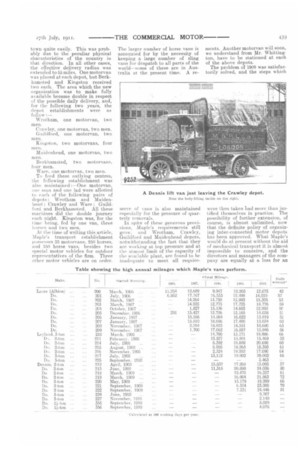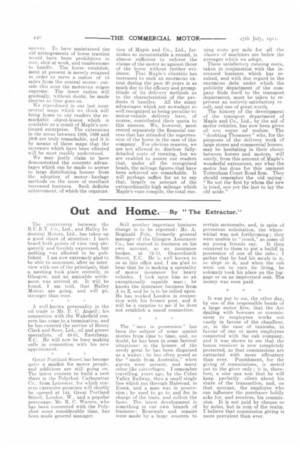Twenty Years of Maple' s Deliveries.
Page 4

Page 5

Page 6

If you've noticed an error in this article please click here to report it so we can fix it.
Economical Running is Secured by High Average Mileage. A Lacre (Albion) Van with over 60,000 Miles to its Credit.
Long-distance transport into the country and abroad offered Maple's no especial problem ; the railway and the steamship were satisfactorily employed for these long-distance deliveries, and even up to the present time Maple's have not yet felt it necessary to modify these arrangements to any drastic extent, although we are informed that, once what may be called the outer home district is efficiently covered, the possibility of superseding railway transport by means of long-distanc:! motor services will be taken in hand as enthusiastically as has been the other problem with which we are dealing in the present article.
On the one hand, Maple's at this time had an almost-perfect system of transport which was specially suitable for the handling of delicate furniture and fabrics of great value which require extra-careful treatment a system which had practically' reached its final limitation, and, on the other hand. there was the ever-growing demand from an increasing clientele for yet further delivery facilities. This was the problem which was before the directors of Maple and Co., in 1908. Instructions were therefore promptly given to the officials of those departments, which were more directly concerned, thoroughly to test several of the latest type of motorvans.
The principal requirement which was to be sought, of course, was reliability ; the capital outlay was not of such vital importance. Exhaus tive tests were then made with various classes of machines, and orders were given for the purchase of two three-ton Leylands, four twoton Leylands. and five two-ton Dennis vans. It will perhaps be well, here, again to note that Maple's had been using 10 two-ton Lacre (Albion) vans for delivery in the inner zone.
The company's own van-building department was then called upon to design and to build the necessary van bodies. These, it was specified, should be capable of taking the largest possible load with all due consideration for the safety of the valuable contents.
In the meantime, the directors had, after eonsiderable deliberation, reached a decision as to the most-suitable centres for the proposed motor-delivery organization.. A start was made at Maidenhead. and a depot was there established and a two-ton Lacre was sent down there and instantly became a success. The old horse depot at Hounslow was evacuated, and Lee Green and Watford soon shared its fate. Wrotham and Berkhamsted took the place of these superseded centres ; Ware gave up • its horse stock, and the stable was converted into a garage. Guildford, in view of its importance as a distributing centre, was chosen For the establishment of a large motor depot, and a year later the depot at Croydon was pushed out to Crawley— further down on the Brighton road. Romford was abandoned, as it Was found that, in spite of the fact that the radius in that direction had been increased to 45 miles, a motor van could do the journey direct from
town quite easily. This was probably due to the peculiar physical characteristics of the country in
that direction. In all other cases, the effective delivery radius was extended to 55 miles. One motorvan was placed at each depot, but Berkhamsted and Kingston received two each. The area which the new organisation was to make fully available became double in respect of the possible daily delivery, and, for the following two years, the depot establishments were as follow : Wrotham, one motorvan, two men.
Crawley, one motorvan, two men. Giiiidford, one motorvan, two men.
Kingston, two motorvans, four men.
Maidenhead, one motorvan, two men.
Berk hamsted, two motorvans, four men.
Ware, one motorvan, two men. To feed these outlying centres, the following establishment was also maintained :-One naotorvan, one man and one lad were allotted to each of the following pairs of depots : Wrotharn and Maidenhead ; Crawley and Ware ; Guildford and Berkhamstecl. All these machines did the double journey each night. Kingston was, for _the ime being, fed by one van, three horses and two men.
Al tile time of writing this article, Maple's transport establishment possesses 33 motorvans, 250 horses, and 350 horse vans, besides two special motor vehicles for outdoor representatives of the firm. Three other motor vehicles are on order.
The larger number of horse vans is accounted for by the necessity of keeping a large number of sling vans for despatch to an parts of the world-some of these are in Australia at the present time. A re
serve or vans is also maintained especially for the pressure of quarterly removals.
In spite of these generous provisions, Maple's requirements still grow, and Wrotham, Crawley, Guildford and Maidenhead depots, notwithstanding the fact that they are working at top pressure and at the utmost limit of the capacity of tha available plant, are found to be inadequate to meet all require
merits. Another motorvan will soon, we understand from Mr. Whittington, have to be stationed at each of the above depots. The problem of 1908 was satisfactorily solved, and the steps which
were then taken had more than justified themselves in practice. The possibility of further extension, of course, is almost unlimited, now that the definite policy of organizing inter-connected motor depots has been approved. What Maple's would do at present without. the aid of mechanical transport it is almost impossible to conceive, and the directors and managers of the company are equally at a loss for an
answer. To have maintained the old arrangements of horse traction would have been prohibitive in cost, slow at work, and cumbersome to handle. The horse establishment at present is merely retained in order to serve a radius of la miles from the central stores : outside this zone the motorvan reigns supreme. The inner radius will gradually, without doubt, be made shorter as time goes on. We reproduced in our last issue several maps which we think will bring home to our readers the remarkable object-lesson which is available as a result of Maple's continued enterprise. The extensions in the areas between 1889, 1899 and 1909 are truly remarkable, and it is by means of these maps that the increases which have been effected will be most readily understood.
We may justly claim to have demonstrated the concrete advantages which can be made to accrue to large distributing houses from the adoption of motor haulage methods on the score of resultant increased business. Such definite achievement, of which the organize
tion of Maple and Co., Ltd., furnishes so incontestable a record, is almost sufficient to enforce the claims of the motor as against those of the horse without further evidence. That Maple's clientele has increased to such an enormous extent during the past 20 years is as much due to the efficacy and promptitude of its delivery methods as to the characteristics of the pro
ducts it handles. All the many advantages which are nowadays so well recognized as being peculiar to motor-vehicle delivery have, of course, contributed their quota to this success. We, however, must record separately the financial success that has attended the supercession of the horse in the case of this company. For obvious reasons, we are not allowed to disclose fullydetailed costs of running, but we are enabled to assure our readers that, under all the recognized heads, the mileage figures that have been achieved are remarkable. It will perhaps suffice for us to say that, largely on account of the extraordinarily-high mileage which Maple's vans compile, the total run
ning costs per mile for all the classes of machines are below the averages which we adopt.
These satisfactory running costs, taken in conjunction with the increased business which has resulted, and with due regard to the enormous debt under which the publicity department of the company finds itself to the transport department, must be taken to represent an entirely-satisfactory result, and one of great worth.
The history of the development of the transport. department of Maple and Co., Ltd., by the aid of motor vehicles, has now been given ab ova usque ad malum. The "doubting Thomases" who, for the purposes of the delivery work of large stores and commercial houses, may be hesitating in their choice between horses and motors, will surely, from this account of Maple's wonderful extensions, see what the motor has done for this eminent Tottenham Court Road firm, They should remember the old saying : "Ile not the first by whom the new is tried, nor yet the last to lay the old aside."




















